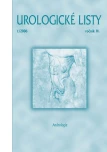PRIAPISM
Authors:
MUDr. Pavel Hanek; doc. MUDr. Ivan Kawaciuk, CSc.
Authors‘ workplace:
Urologická klinika UK 2. LF a FN v Motole, Praha
Published in:
Urol List 2006; 4(1): 53-56
Overview
Priapism is a relatively rare disease characterized by prolonged erection that is not connected with sexual stimulation, is uncomfortable or even painful, and has no relation to ejaculation. Priapism can be preceded by sexual intercourse, but it is not a rule. Although priapism affects all age categories, the highest incidence is observed in men in their forties and fifties. Since priapism occurs very rarely, urologists could be sometimes at a loss to select an appropriate therapy. Although an appropriate therapeutic procedure is selected, priapism leads to subsequent erectile dysfunction in 50% of cases. Considering fast development of pathophysiological processes during low-flow priapism, it is necessary to control it within 24 hours in order to prevent later consequences. When initial conservative therapy fails, surgical approach should be selected without hesitation.
KEY WORDS:
priapism, high-flow priapism, low-flow priapism, spongiocavernous shunt, erectile dysfunction
Sources
1. Pohl J et al. Priapism: a three-phase concept of management according to aethiology and prognosis. Br J Urol 1986; 58: 113-118.
2. El-Bahnasawy MS. Low-flow priapism: risk factor of erectile dysfunction. BJU Int 2002; 89: 285-290.
3. Parivar F. Priapism. In: Hellstrom WJG (ed). Male Infertility and Sexual dysfunction. Berlin: Springer-Verlag 1997; 401-408.
4. Spycher MA, Hauri D. The ultrastructure of the erectile tissue in priapism. J Urol 1986; 135: 142-147.
5. Hubler J. Methylene blue as means of treatment for priapism caused byintracavernous injection to combat erectile dysfunction. Int Urol Nephrol 2003; 35(4): 519-521.
6. Mejean A. Letter to the editor. J Urol 1993; 149: 1149.
7. Van der Horst C. Priapism-etiology, pathophysiology and management. International Braz J Urol 2003, 29(5): 391-400.
8. Winter CC. Cure of idiopathic priapism. New procedure for creating fistula between glans penis and corpora cavernosa. Urology 1976; 8: 389.
9. Winter CC. Experience with 105 patients with priapism: update review of all aspects. J Urol 1988; 140: 980-983.
10. Quackels R. Cure dur cos de priapisme par anastome cavernosospongieuse. Acta Urol 1964; 32: 5.
11. Barry JM. Priapism: treatment with corpus cavernosum to dorsal vein of penis shunts. J Urol 1976; 116: 754-756.
12. Grayhack JT. Venous bypass to control priapism. Invest Urol 1964; 1: 509-513.
13. Kuefer R. Changing diagnostic and therapeutic concepts in high-flow priapism. Int J Impot Res 2005; 17(2): 109-113.
14. Savoca G. Sexual function after highly selective embolizationof cavernous artery in patients with high flow priapism: long term followup. J Urol 2004; 172(2): 644-647.
15. Bartsch G. High-flow priapism: Colour-Doppler ultrasound-guided supraselective embolization therapy. World J Urol 2004; 22(5): 368-370.
16. Kabalin JN. Corporeal fibrosis as a result of priapism prohibiting function of self-contained inflatable penile prosthesis. Urology 1994; 43: 401-403.
Labels
Paediatric urologist UrologyArticle was published in
Urological Journal

2006 Issue 1
Most read in this issue
- INTRACAVERNOUS VASOACTIVE THERAPY OF ERECTILE DYSFUNCTION
- PENILE PLASTIC INDURATION (PEYRONIE'S DISEASE)
- TRANSSEXUALISM AND SEX CONVERSION SURGERY
- MALE FACTOR INFERTILITY: EVALUATION AND MANAGEMENT
